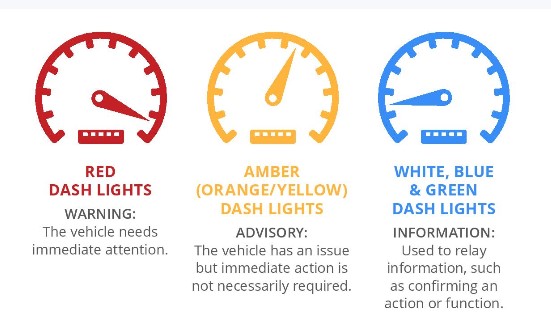Dashboard warning lights are critical to vehicle maintenance and safety, but they are only effective if you know what they mean.
Understanding your dashboard warning lights can keep you from driving an unsafe vehicle and help you avoid expensive repairs. Learn more about dashboard warning lights and five that you should never ignore here.
Table of Contents
What Is a Dashboard Warning Light?
One of the earliest dashboard warning lights was in a 1933 Hudson. It was a small red light that remained illuminated if the vehicle’s battery wasn’t charging. It served as a symbol for drivers to get their electrical systems checked at the dealership.
Today, dashboard warning lights serve similar purposes. You have probably seen small symbols illuminate on your vehicle’s dashboard when you turn it on. Generally, the lights turn on for a moment to signal they’re functioning, and then they turn off.
A dashboard warning light that illuminates when the others have turned off signals that something is wrong with the vehicle. However, it is not a reason to panic. Warning lights have different meanings. They may simply advise you that your headlights are in use or warn you of a major engine issue.
Infographic provided by Goodwill Car Donations, donating a car in Florida
Warning Light Categories
There are three categories of dashboard warning lights. Red dash lights are generally the most serious and require you to seek immediate attention for your vehicle. Amber, yellow, or orange dash lights symbolize that an issue is present, but you likely do not need to pull the vehicle over or seek immediate assistance.
Blue, green, or white warning lights typically relay information and do not signal an emergency. They often symbolize the status of a vehicle feature. For instance, a light may show that the cruise control is in use or that the high-beam headlights are functioning.
Dashboard Warning Lights You Should Never Ignore
Several dashboard warning lights signify severe mechanical or safety issues. The following are five warning lights you should never ignore.
Check engine
The check engine light is one of the most ambiguous dashboard warning lights. It’s typically yellow and in the shape of a car engine. An illuminated check engine light can signify a long list of problems that range from minor to severe.
This light illuminates when there’s any kind of issue with the vehicle’s emissions system. It could mean there’s a loose wire or could symbolize a major engine problem. The best thing to do when you see an illuminated check engine light is to bring your vehicle to a trusted mechanic for a diagnostic test.
There are a few instances when you should pull over immediately after seeing an illuminated check engine light. A blinking check engine light signifies a dangerous issue that could permanently damage your vehicle’s powertrain or put you and your passengers in danger. You should also pull over if the check engine light illuminates while driving and the car starts acting strangely.
Coolant temperature
The coolant temperature light is more straightforward. In most cars and trucks, it looks like a thermometer dipped in water.
This dashboard warning light symbolizes that the vehicle is running hot. It’s one of the more serious dashboard warning lights, as operating a vehicle while overheating can cause permanent damage. You should pull over as soon as it is safe and seek assistance from a tow company or mechanic.
Oil pressure
Insufficient oil in the engine can cause significant engine damage and exorbitant vehicle repair bills. The oil pressure warning light is difficult to miss; it’s in the shape of an oil can with a drop of oil coming out.
The problem could be as simple as needing to top off your oil or as serious as a broken oil pump. Pull over as soon as it’s safe and check your oil level. If it is a bit low and the light turns off after adding oil, you’re probably good to go. However, if the oil light remains on or turns on again a short distance down the road, it’s time to have the issue assessed.
Brake system
The brake system light is designed to keep you and your passengers safe and ignoring it can put everyone on the road in danger. The symbol is an exclamation point inside a circle with two half circles on the sides.
The brake system light may simply signify that you left your parking brake engaged. However, it can also signal a more severe problem, such as a failure in your antilock braking system (ABS), low brake fluid, or worn brake pads. These are all issues that should be addressed to ensure your braking system is operating properly. A blinking brake system light is even more urgent and means there’s an issue to resolve immediately.
Battery warning light
The battery warning light is relatively easy to recognize. Typically, it’s a silhouette of a battery with plus and minus signs inside. This light symbolizes an issue with your battery, such as corroded battery wires, a voltage regulator issue, or a problem with the alternator belt.
A battery light that illuminates while driving means you should pull over safely and seek assistance. The battery could die while you continue driving, putting you and everyone on the road in danger.
Educate Yourself to Stay Safe
Don’t fear your dashboard warning lights. They’re designed to help you understand what’s happening with your vehicle, so you can take the necessary action. Ignoring a dashboard warning light can put you and other drivers in danger. It can also lead to costly or irreversible vehicle damage.
Steering clear of safety issues and vehicle trouble can be as simple as knowing what dashboard lights mean and seeking the appropriate assistance when required. Learn more about dashboard warning lights and their significance in the accompanying resource.

